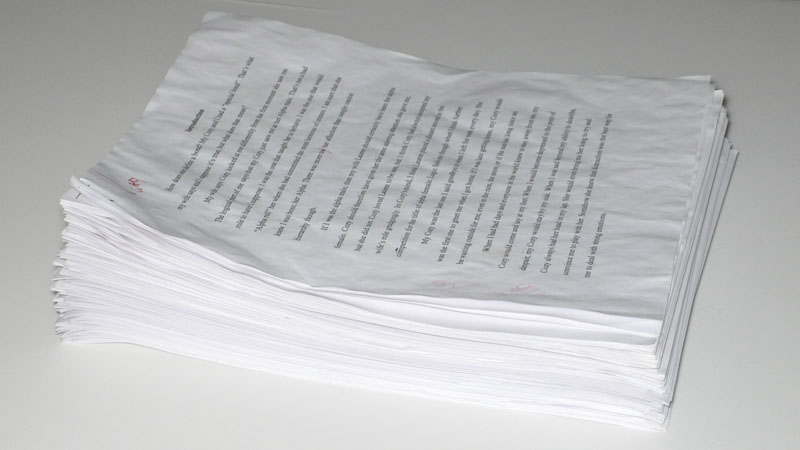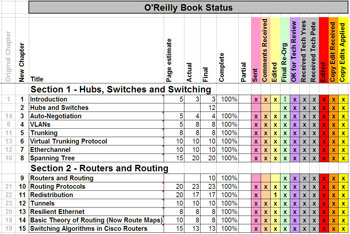
Writing a book is an arduous process. Anyone who says otherwise probably hasn’t written a book, or if they have, it likely hasn’t been published. As I wrote in my blog entry
What it Takes to be a Published Author, writing is harder than most people think. Sure it is sometimes easy to sit down and put words on paper, but almost 100% of the time, those words are crap. While the mechanics of writing are different for everyone, I thought some might be interested in how I approach the task of writing a book.
Stage 1: Stream of Consciousness Writing
The first step is to get all the garbage in my head onto paper. This is the easy part for me. Like most writers, I do have battles with writer’s block, but for the most part the task of articulating complex ideas comes easy to me. During this stage I work hard not to spend time correcting and fiddling with sentence structure. The ideas need to be translated to words, and that’s the task on which I try to focus. Grammar, word order and any other editing is saved for later revisions.
Some people like to write a paragraph and then fiddle with it until it reflects the perfection of a final draft. I prefer to get the entire story out of my head and into the computer as quickly as my fingers and aging brain will allow. This gives me the added benefit of completing the first draft much sooner than if I endlessly fiddled with each paragraph. Completing a draft is a pretty big milestone in any writing endeavor, and being an endorphin addict, I go for the fix as soon as I can. Once the first draft is done I proceed to dance with the dogs. I usually write late at night, so there is little risk of anyone seeing my 2:00 A.M. dance of completion.
Stage 2: First Draft Editing
Once the dancing is done and I’ve had some recovery sleep, I print out the entire thing and give it to my wife, Lauren. She reads it, marks it up with a red pen, and gives me her opinion regardless of whether it’s good or bad. She marks up typos and acts as my first line of defense against stupid, libelous or just plain bad writing.
When I get Lauren’s notes back, I set about the first draft editing process. The primary goal of this stage is to to get rid of the crap. I feel that a primary goal for any writer should be to use as few words as possible. As William Zinsser says in his fabulous book On Writing Well, “Clutter is the disease of American writing. We are a society strangling in unnecessary words, circular constructions, pompous frills and meaningless jargon.”
The stream of consciousness process from step one results in many unnecessary words. Entire chapters are often culled during my first draft editing since anything that doesn’t matter is unceremoniously deleted. Deciding what matters is a surprisingly easy process when it comes to chapters and paragraphs. Finding unnecessary words can be a more daunting task.
The removal of unnecessary words is, to me, the essence of writing. This stage of editing is what starts to make a great story from a good one. In the book I’m working on now, I had this clause in the first chapter: “I don’t know if that was true or not…” The “or not” was completely superfluous. “I don’t know if that was true” by it’s very nature, includes the possibility that it was not true. the words “or not” were unnecessary. Master the skill of removing your own useless words and you’ll make a big leap towards becoming a better writer.
At the end of this stage I hope to have removed 30% of my text. There is no science in that number, but 30% makes me feel like I’ve done my job. The amount of work cut depends on how well I wrote the first draft.
Stage 3: Second Draft Editing
Sometimes I write chapters that flow like poetry written by angels. These masterpieces are invariably followed by rambling pages of nonsense written by a psychotic monkey on a Benadryl bender. Being responsible for every word, I set out to level the playing field. Since I don’t want to degrade the beauty of the great chapters, I endeavor to make the terrible work flow like poetry.
Making words flow is an art that many writers – even famous published ones – seem unable to grasp. A chapter that flows well is more enjoyable for the reader. A chapter that doesn’t flow well might be called choppy or described as all over the place. Often though, the reader will just put the book down in the store and walk away.
The goal of this stage is readability. Every sentence should flow with its own cadence, and it should lead the reader by the hand to the next sentence. The last sentence in each paragraph should entice the reader to continue to the next. Every sentence is a chance to to pull the reader deeper into my world or to lose them altogether.
A great way to test the flow of your writing is to read it aloud. As goofy as that sounds, it seems to work. I try to do this at home, since apparently some customers have a problem with me reading aloud in Starbucks.
Stage 4: Outside Editing
When all the pages have been purged of fluff and the entire work flows to my satisfaction, I start to like the book. Until I like the book, no one but Lauren gets to read it.
At this point I send copies to people who have agreed to edit my work in one way or another. I may choose someone because they have an advanced degree in English, or because they are a writer. I may choose someone who is an expert in the field of which I have written, or someone who just likes to read. The more feedback I can get from a variety of viewpoints, the better I can make the book. What is important to me here, is the quality of the feedback I get. I’m not going to give someone a copy only to get an “It was great – I really liked it” in return. That experience is reserved for paying customers.
I try not to touch the book until I get a response back, or for 30 days, whichever comes first. This lets me view the book as if it were new to me. Writing the same story every day for months means that I have become too close to the story. Taking a break lets me focus on it more as a reader would.
Stage 5: Final Editing
I may not use all of the feedback I get, but I take it all to heart. Sometimes what seems like a perfectly crafted sentence to me is confusing to someone else. If it confused one person, it will confuse others, so it is probably a good idea to tweak it a bit. If I’ve done my work in the first few stages well, this stage doesn’t take much time.
Stage 6: Submission
Off it goes into the harsh world of agents, publishers and the world at large. Edits beyond this point are as an agent or editor might request or demand. That’s a tale for another time.

Tracking Progress
For each book, I maintain a spreadsheet. For each stage I make a list of the chapters, how many pages and words are in each, and I check if it has been edited yet. This lets me track my progress and see visually how much work remains.
Final Thoughts
As a published author, one of the most common questions I get is “How did you do it?” People seem amazed that I could organize my thoughts over 600 pages. I try to view writing one sentence at a time, then one paragraph, then one chapter. Beyond that it’s like moving colored pencils in the box until they look nice. You don’t need to worry about how the pencils are made, but the order seems obvious when you look at them from a distance. So it is with chapters in my mind.
Writing is a very personal experience, so what works for me may not work for you. What matters is this: if you want to write, then write. The steps that I use help me write large projects. I hope that my experience might help you with yours.
Donate: PayPal Crypto:
ETH: 0x0AC57f8e0A49dc06Ed4f7926d169342ec4FCd461
Doge: DFWpLqMr6QF67t4wRzvTtNd8UDwjGTQBGs
